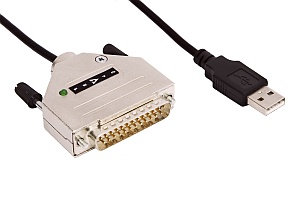USB Control Amplifier Interface
|

Remote Control of FEMTO Amplifiers and Photoreceivers
In addition to manual control elements, many FEMTO amplifiers and photoreceivers feature a digital interface for remote control of all main functions. Depending on the model, gain and filter settings can be remotely controlled and status information like Overload or Unlocked can be read from the device. This is especially useful in automated measurement systems or for remote sensing at places difficult to access.
The LUCI-10 USB control interface establishes the link between the FEMTO unit and a standard Windows PC with USB port. The interface is bus-powered through the USB port and the electronics is fully integrated inside the D-Sub hood. Thus, a very compact and easy to use interface solution can be realized.
Opto-Isolation of Amplifier Signal Path from PC USB Port
The LUCI-10 USB control interface supports opto-isolation of the PC USB port from the signal path of the connected FEMTO amplifier or photoreceiver. While opto-isolators inside the LUCI-10 are used for the status inputs, the isolation of the output ports is achieved by opto-isolators inside the individual FEMTO amplifiers and photoreceivers. This combination allows full separation of the PC and amplifier ground lines to guarantee signal integrity and low noise performance of the remote controlled FEMTO unit.
Drivers, Application Software and VI’s for LabVIEW Included on CD
The LUCI-10 hardware comes with an extensive software package containing all necessary drivers and software examples for easy use on standard Windows PCs. A self-starting program guides you through the software installation. In addition to the Dynamic Link Library (.dll) various Graphic User Interfaces (GUI’s) are included as .exe and LabVIEW project files. The FEMTO Library and sample VI’s will help generate your own control software in a LabVIEW environment.
| Model | LUCI-10 |
|---|---|
| Bus Interface | USB 2.0 Compatible |
| Digital I/O Interface | 16 Digital Output Lines, 3 Opto-Isolated Input Lines |
| Supply | PS USB Bus-Powered |
| Connector | USB Type A, D-Sub, Male (25 Pins) |
| Case | Zinc Die-Cast Hood, Nickel Plated, with Jack Screws, Weight 130 g (0.3 lb.) |
| Software | System Driver (.dll) Compatible with C/C++, LabVIEW Library, GUI |
| System Requirements | Microsoft Windows XP SP 2 or Higher, Intel Pentium III or Equivalent/Higher, 512 MB RAM or More, 200 MB of Hard Disk Space, USB 1.1 or 2.0 Port |
| Optional Requirements | For development of own application programs an additional development environment like LabVIEW Version 8 (or higher) or C/C++ is required. |
LUCI-10 supports all standard FEMTO amplifiers and photoreceivers with 25 pin D-Sub socket except model HLVA-100. A National Instruments LabVIEW™ license is not included in the software package. For use of the GUI application programs the LabVIEW Run-Time Engine is required. If not detected on the host PC during the installation process, the LabVIEW Run-Time Engine will be installed automatically from the CD. LabVIEW, National InsTable 82truments and NI are trademarks of National Instruments. Neither FEMTO Messtechnik GmbH, nor any software programs or other goods or services offered by FEMTO Messtechnik GmbH, are affiliated with, endorsed by, or sponsored by National Instruments. Microsoft and Windows are either registered trademarks or trademarks of Microsoft Corporation in the United States and/or other countries.
